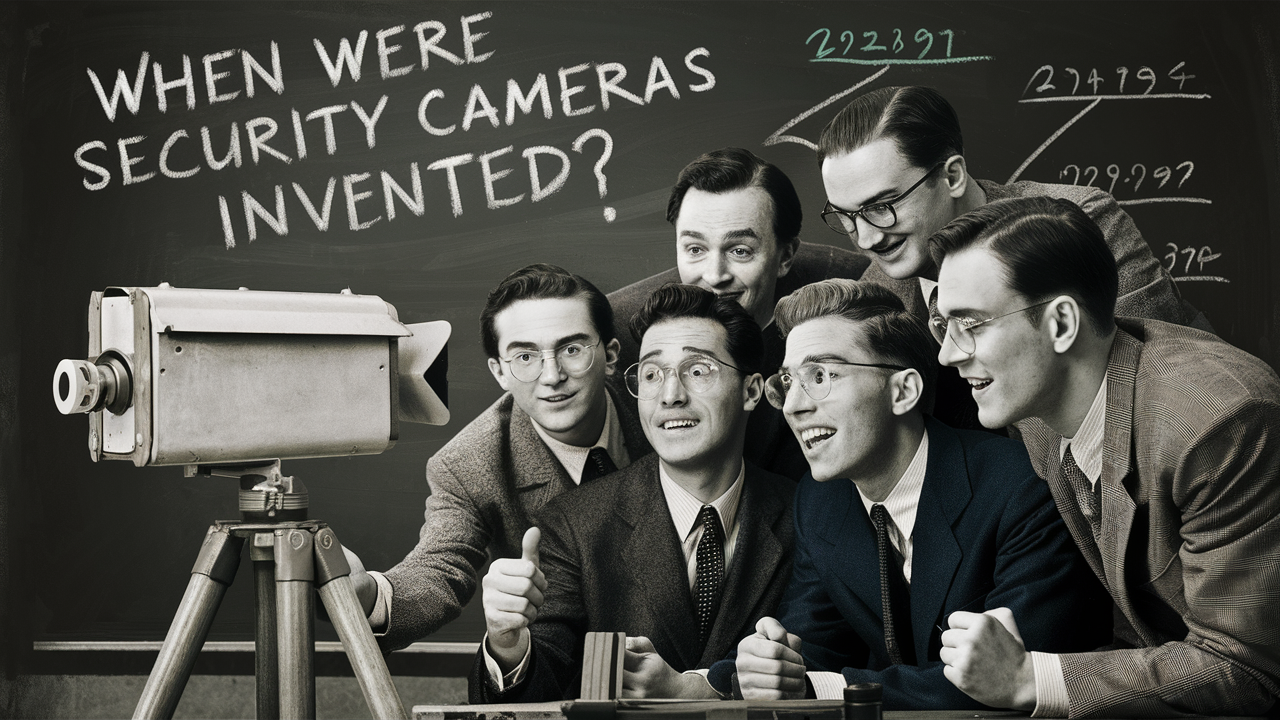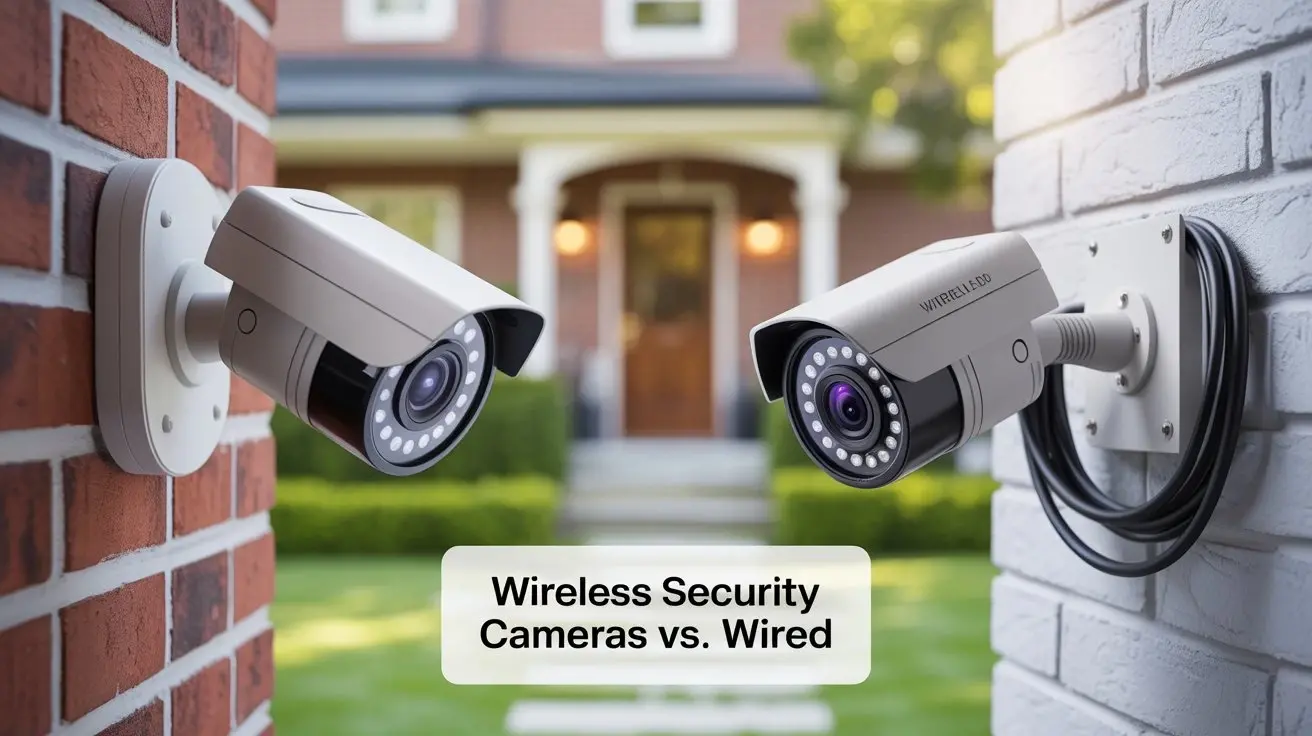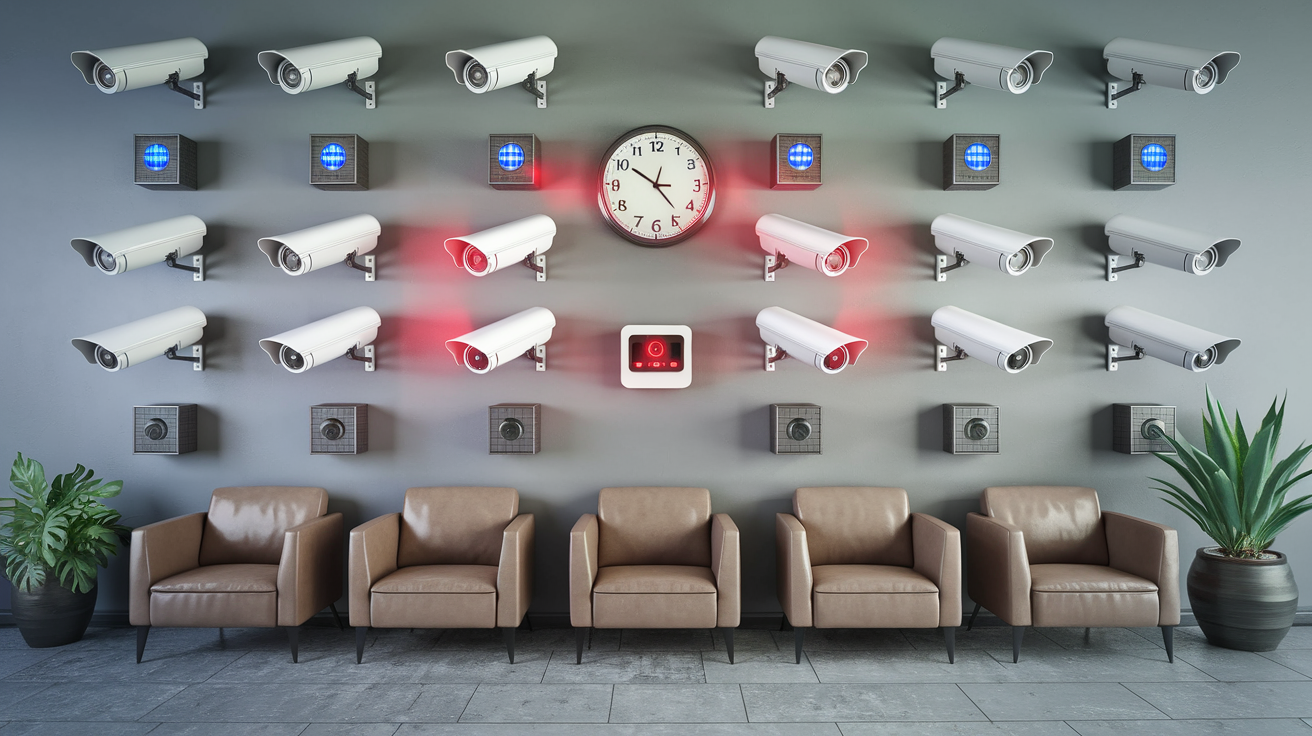When Were Security Cameras Invented?
Security cameras, now a cornerstone of modern surveillance, have a rich history that spans over a century, evolving from rudimentary mechanical devices to sophisticated digital systems integrated with artificial intelligence. Their invention and development were driven by the need for security, monitoring, and documentation in various settings, from banks to homes. This comprehensive exploration traces the origins of security cameras, key milestones in their evolution, and their transformative impact on society, culminating in the advanced systems we use in 2025.
The Birth of Security Cameras: Early Beginnings
The concept of security cameras emerged in the early 20th century, though the technology was far from what we recognize today. The earliest precursor to security cameras can be traced to the 1920s, with the invention of closed-circuit television (CCTV) systems. These systems were designed to transmit video signals from a camera to a specific monitor, unlike broadcast television, which sent signals to a wide audience.
1927: The First CCTV Experiment
In 1927, Russian engineer Léon Theremin demonstrated one of the earliest closed-circuit television systems in the Soviet Union. His system used a mechanical scanning device to capture and transmit images to a receiver, primarily for experimental purposes. While not explicitly designed for security, this laid the groundwork for future surveillance technology by proving that images could be transmitted over a closed system.
Note: Theremin’s system was rudimentary, with low-resolution images and bulky equipment, making it impractical for widespread use.
1942: The First True Security Camera
The first documented use of a security camera occurred in 1942 in Nazi Germany, credited to engineer Walter Bruch. Bruch developed a CCTV system to monitor the launch of V-2 rockets at the Peenemünde research facility. The system used analog cameras to capture live footage, which was transmitted to a control room for real-time observation. This marked the first practical application of cameras for security purposes, specifically to ensure the safety and success of rocket launches by monitoring for malfunctions or intrusions.
Warning: Early CCTV systems were expensive and required dedicated wiring, limiting their use to high-security military and industrial applications.
Post-War Advancements: 1950s–1960s
After World War II, CCTV technology began to spread beyond military applications. The 1950s saw significant advancements in camera design and accessibility, driven by the growing need for security in commercial and public spaces.
1950s: Commercial Use in Banks and Stores
In the 1950s, banks and retail stores in the United States and Europe started adopting CCTV systems to deter theft and monitor transactions. These early systems used vacuum tube cameras, which were bulky and required constant maintenance. The footage was recorded on magnetic tape or monitored live by security personnel. Companies like Vericon in the U.S. pioneered commercial CCTV systems, installing them in high-value environments like jewelry stores and bank vaults.
1968: The Introduction of Video Tape Recorders (VTRs)
The invention of the video tape recorder (VTR) in 1968 revolutionized security cameras by allowing footage to be recorded and stored for later review. Before VTRs, monitoring was strictly real-time, requiring constant human oversight. The ability to record footage expanded the use of cameras in law enforcement, enabling evidence collection for crimes like shoplifting or vandalism.
The Rise of Modern CCTV: 1970s–1980s
The 1970s and 1980s marked a turning point for security cameras, with advancements in electronics and the introduction of more compact, affordable systems.
1970s: Charge-Coupled Device (CCD) Sensors
In 1969, Willard Boyle and George E. Smith at Bell Labs invented the charge-coupled device (CCD) sensor, which became the backbone of modern security cameras. By the 1970s, CCD sensors replaced vacuum tubes, offering higher resolution, better low-light performance, and smaller camera sizes. This made CCTV systems more practical for widespread use in public spaces, such as train stations and government buildings.
1980s: Expansion to Public and Private Sectors
By the 1980s, security cameras became common in urban areas. Cities like London and New York installed CCTV systems to combat crime in high-traffic areas. The development of multiplexing technology allowed multiple cameras to record to a single VTR, reducing costs and enabling multi-angle surveillance in places like casinos and shopping malls. However, analog systems still required extensive wiring and on-site monitoring, limiting their scalability.
The Digital Revolution: 1990s–2000s
The 1990s brought a seismic shift in security camera technology with the transition from analog to digital systems, driven by advancements in computing and networking.
1990s: Digital Video Recorders (DVRs)
The introduction of digital video recorders (DVRs) in the late 1990s replaced analog VTRs, allowing footage to be stored on hard drives in digital format. DVRs offered higher storage capacity, easier retrieval, and remote access capabilities. This era also saw the rise of network-based cameras, or IP (Internet Protocol) cameras, which transmitted video over the internet, eliminating the need for dedicated coaxial cables.
1996: The First IP Camera
In 1996, Axis Communications releasedევ System:
When Were Security Cameras Invented?
Security cameras, now a cornerstone of modern surveillance, have a rich history that spans over a century, evolving from rudimentary mechanical devices to sophisticated digital systems integrated with artificial intelligence. Their invention and development were driven by the need for security, monitoring, and documentation in various settings, from banks to homes. This comprehensive exploration traces the origins of security cameras, key milestones in their evolution, and their transformative impact on society, culminating in the advanced systems we use in 2025.
The Birth of Security Cameras: Early Beginnings
The conceptInsets of security cameras emerged in the early 20th century, though the technology was far from what we recognize today. The earliest precursor to security cameras can be traced to the 1920s, with the invention of closed-circuit television (CCTV) systems. These systems were designed to transmit video signals from a camera to a specific monitor, unlike broadcast television, which sent signals to a wide audience.
1927: The First CCTV Experiment
In 1927, Russian engineer Léon Theremin demonstrated one of the earliest closed-circuit television systems in the Soviet Union. His system used a mechanical scanning device to capture and transmit images to a receiver, primarily for experimental purposes. While not explicitly designed for security, this laid the groundwork for future surveillance technology by proving that images could be transmitted over a closed system.
Note: Theremin’s system was rudimentary, with low-resolution images and bulky equipment, making it impractical for widespread use.
1942: The First True Security Camera
The first documented use of a security camera occurred in 1942 in Nazi Germany, credited to engineer Walter Bruch. Bruch developed a CCTV system to monitor the launch of V-2 rockets at the Peenemünde research facility. The system used analog cameras to capture live footage, which was transmitted to a control room for real-time observation. This marked the first practical application of cameras for security purposes, specifically to ensure the safety and success of rocket launches by monitoring for malfunctions or intrusions.
Warning: Early CCTV systems were expensive and required dedicated wiring, limiting their use to high-security military and industrial applications.
Post-War Advancements: 1950s–1960s
After World War II, CCTV technology began to spread beyond military applications. The 1950s saw significant advancements in camera design and accessibility, driven by the growing need for security in commercial and public spaces.
1950s: Commercial Use in Banks and Stores
In the 1950s, banks and retail stores in the United States and Europe started adopting CCTV systems to deter theft and monitor transactions. These early systems used vacuum tube cameras, which were bulky and required constant maintenance. The footage was recorded on magnetic tape or monitored live by security personnel. Companies like Vericon in the U.S. pioneered commercial CCTV systems, installing them in high-value environments like jewelry stores and bank vaults.
1968: The Introduction of Video Tape Recorders (VTRs)
The invention of the video tape recorder (VTR) in 1968 revolutionized security cameras by allowing footage to be recorded and stored for later review. Before VTRs, monitoring was strictly real-time, requiring constant human oversight. The ability to record footage expanded the use of cameras in law enforcement, enabling evidence collection for crimes like shoplifting or vandalism.
The Rise of Modern CCTV: 1970s–1980s
The 1970s and 1980s marked a turning point for security cameras, with advancements in electronics and the introduction of more compact, affordable systems.
1970s: Charge-Coupled Device (CCD) Sensors
In 1969, Willard Boyle and George E. Smith at Bell Labs invented the charge-coupled device (CCD) sensor, which became the backbone of modern security cameras. By the 1970s, CCD sensors replaced vacuum tubes, offering higher resolution, better low-light performance, and smaller camera sizes. This made CCTV systems more practical for widespread use in public spaces, such as train stations and government buildings.
1980s: Expansion to Public and Private Sectors
By the 1980s, security cameras became common in urban areas. Cities like London and New York installed CCTV systems to combat crime in high-traffic areas. The development of multiplexing technology allowed multiple cameras to record to a single VTR, reducing costs and enabling multi-angle surveillance in places like casinos and shopping malls. However, analog systems still required extensive wiring and on-site monitoring, limiting their scalability.
The Digital Revolution: 1990s–2000s
The 1990s brought a seismic shift in security camera technology with the transition from analog to digital systems, driven by advancements in computing and networking.
1990s: Digital Video Recorders (DVRs)
The introduction of digital video recorders (DVRs) in the late 1990s replaced analog VTRs, allowing footage to be stored on hard drives in digital format. DVRs offered higher storage capacity, easier retrieval, and remote access capabilities. This era also saw the rise of network-based cameras, or IP (Internet Protocol) cameras, which transmitted video over the internet, eliminating the need for dedicated coaxial cables.
1996: The First IP Camera
In 1996, Axis Communications released the AXIS Neteye 200, the world’s first IP camera. This device transmitted video directly over the internet, enabling remote monitoring from anywhere with an internet connection. IP cameras marked a significant leap forward, offering higher resolution and scalability compared to analog systems. They quickly gained popularity in businesses and government facilities.
Early 2000s: High-Definition and Wireless Technology
The early 2000s saw further refinements in security camera technology, including the adoption of high-definition (HD) video and wireless connectivity.
2000s: HD and Megapixel Cameras
By the mid-2000s, HD and megapixel cameras became standard, offering resolutions of 720p and 1080p compared to the 480p of analog systems. These cameras provided clearer images, making it easier to identify faces and license plates. The shift to digital also enabled advanced features like motion detection and remote alerts.
Wireless Cameras
The rise of Wi-Fi in the 2000s led to the development of wireless security cameras, which eliminated the need for extensive cabling. Brands like D-Link and later Arlo introduced wireless models that were battery-powered and easy to install, making them accessible to homeowners. However, early wireless cameras faced challenges with battery life and signal reliability.
The Modern Era: 2010s–2025
The 2010s and beyond brought transformative advancements in security camera technology, driven by artificial intelligence, cloud computing, and smart home integration.
2010s: AI and Cloud Storage
The integration of artificial intelligence (AI) in the 2010s revolutionized security cameras. AI-powered features like facial recognition, object detection, and behavior analysis enabled cameras to differentiate between people, vehicles, and animals, reducing false alarms. Companies like Nest (acquired by Google) and Ring introduced cloud-based storage, allowing users to access footage remotely without physical storage devices.
2015: 4K Resolution and Smart Home Integration
By 2015, 4K resolution cameras became mainstream, offering ultra-high-definition footage for precise identification. Smart home platforms like Amazon Alexa, Google Assistant, and Apple HomeKit integrated with cameras, enabling voice control and automation. For example, Ring cameras could trigger smart lights upon detecting motion.
2020s: Solar Power and Advanced AI
By 2025, advancements like solar-powered cameras (e.g., Eufy SoloCam S340) and continuous recording capabilities (e.g., Reolink Altas PT Ultra) have made security cameras more sustainable and user-friendly. AI-driven analytics now include package detection, license plate recognition, and predictive alerts, enhancing security for both residential and commercial users.
Impact of Security Cameras on Society
Security cameras have profoundly impacted society, offering both benefits and challenges:
- Crime Deterrence: Visible cameras reduce crime rates by deterring potential intruders. Studies indicate a 13–20% drop in property crimes in areas with CCTV.
- Law Enforcement: Footage from security cameras has become critical evidence in criminal investigations, aiding in convictions.
- Privacy Concerns: The proliferation of cameras has raised concerns about mass surveillance and data privacy, especially in public spaces.
- Commercial Use: Businesses use cameras for loss prevention, employee monitoring, and customer safety.
- Home Security: Affordable, user-friendly cameras have made home surveillance accessible, with millions of households using systems like Ring and Arlo.
Warning: Improperly secured cameras can be hacked, compromising privacy. Always use strong passwords and two-factor authentication.
Conclusion
Security cameras were first invented in 1942 by Walter Bruch for monitoring V-2 rocket launches, but their origins trace back to Léon Theremin’s 1927 CCTV experiments. Over the decades, advancements like CCD sensors, DVRs, IP cameras, AI, and 4K resolution have transformed them into indispensable tools for security. From their early use in military and commercial settings to their ubiquity in homes and public spaces by 2025, security cameras have evolved dramatically. While they enhance safety and deter crime, they also raise privacy concerns that require careful management. Understanding their history and capabilities helps users make informed decisions about implementing these powerful devices.






